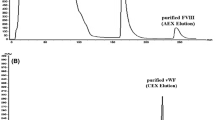Conclusions
The Method M process was developed to reduce the risk of virus transmission associated with the therapeutic use of AHF products. The Method M process uses a powerful viral inactivation approach and consistently results in a high-purity F VIII preparation. The extent to which F VIII is purified in the Method M process is important in considering the reduction in virus. Protein contaminants such as fibrinogen and fibronectin in the final product provide easily measurable parameters of process efficiency in terms of contaminant reduction. However, it is essential to note that protein contaminant levels in the final product are meaningful only when the steps in the purification process are understood. Precipitation steps and/or ion-exchange steps that reduce protein contamination do not necessarily reflect virus reduction. With the exception of F VIII R∶Ag, which appears to associate specifically with monoclonal-antibody-bound F VIII, all other protein and reagent contaminants are consistently reduced during the immunoaffinity step of the Method M process. Given the extent of viral inactivation that occurs during TNBP/detergent treatment and the extent of contaminant reduction that takes place during the immunoaffinity step, Hemofil M AHF is considered to be substantially safe with respect to viral contamination.
Similar content being viewed by others
References
Derse PH (1969) U. S. Clearinghouse, Federal Science and Technology Information, P. B. Report 195153
Fricke WA (1990) Evaluation of the risk of hepatitis from clotting factor concentrates. In: Kasper CK (ed) Recent advances in hemophilia care. Alan R. Liss, New York, pp 161–166
Gomperts E (1988) Hemofil M: characteristics, pharmacokinetics, efficacy and safety. In: Roberts HR (ed) Biotechnology and the promise of pure factor VIII. Baxter Scientific, Brussels, pp 41–47
Gomperts E, De Biasi R, Hemofil M Study Group (1991) Antihemophilic factor isolated with monoclonal antibody. Proceedings of the XIX WFH. (in press)
Homburger F (1968) U. S. Clearinghouse Federal Science and Technology Information, P. B. Report 183027
Hopper SS, Hulpieu HR, Cole VV (1949) Some toxicological properties of surface-active agents. J Am Pharm Assoc 428
Horowitz B (1988) Virus sterilization by treatment with tri-(n-butyl) phosphate/detergent mixtures. In: Roberts HR (ed) Biotechnology and the promise of pure factor VIII. Baxter Scientific, Brussels, pp 49–55
Horowitz B, Wiebe ME, Lippin A, Stryker MH (1985) Inactivation of viruses in labile blood derivatives: I. Disruption of lipid-enveloped viruses by tri (n-butyl) phosphate detergent combinations. Transfusion 25: 516–522
Ingerslev J, Wallevik K (1990) Quantities of murine immunoglobulin and factor VIII:Ag in factor VIII concentrates prepared by monoclonal antibody techniques. In: Kasper CK (ed) Recent advances in hemophilia care. Alan R. Liss, New York, pp 325
Piszkiewicz D, Tondreau SC (1990) Inactivation of HIV-2 by solvent/detergent treatment. Transfusion 70: 192
Piszkiewicz D, Sun CS, Tondreau SC (1989) Inactivation and removal of human immunodeficiency virus in monoclonal purified antihemophilic factor (human) (Hemofil M). Thromb Res 55: 627–634
Prince AM, Horowitz B, Brotman B (1986) Sterilisation of hepatitis and HTLV-VIII viruses by exposure to tri (n-butyl)-phosphate and sodium cholate. Lancet I: 706–710
Windholz M (ed) (1976) The Merck index, 9th edn. Merck and Company, Rahway, New Jersey
Author information
Authors and Affiliations
Rights and permissions
About this article
Cite this article
Griffith, M. Ultrapure plasma factor VIII produced by anti-FVIIIc immunoaffinity chromatography and solvent/detergent viral inactivation. Characterization of the Method M process and Hemofil M antihemophilic factor (human). Ann Hematol 63, 131–137 (1991). https://doi.org/10.1007/BF01703243
Issue Date:
DOI: https://doi.org/10.1007/BF01703243




